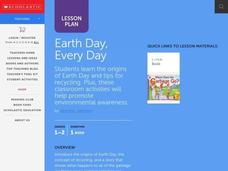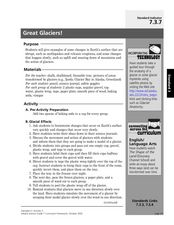Curated OER
The Garbage Patch: Two Earth day Lessons
Students view a seven minute video called Gorilla in the Greenhouse. In this Earth day lesson, students review the history of Earth day. Students work in groups to describe the life cycle of a plastic bag. Students understand that...
Curated OER
Message in the Waves :Two Earth Day Lessons for Middle School Students
Fifth graders are introduced to Earth day and study the nesting colonies of Midway. In this Earth Day lesson students watch an online clip and see the effects our waste has on wildlife.
Curated OER
Earth Day, Every Day
First graders celebrate Earth Day. In this Earth Day lesson plan, 1st graders listen to a book Where Does the Garbage Go? by Paul Showers, and list facts about the garbage we throw away. Students use the Think-Pair-Share method.
Curated OER
Earth Day Poster
Students promote Earth Day. In this Earth Day lesson, students create an Earth Day catch phrase and use graphic art design principles to make an Earth Day poster.
Curated OER
Fruit Flowers
Make a fun and healthy snack to celebrate Earth Day! Included are the directions for making a flower out of strawberries, kiwi, mint leaves, and raspberry licorice. Just provide your class with the materials and watch them make edible...
Curated OER
Earth Day and "The Lorax" Lesson Plans
Earth Day can be a way for students to explore their relationship to the world around them and read great literature like "The Lorax."
Curated OER
The Changing Earth
Students observe and analyze weathering. In this earth science lesson, students demonstrate physical and chemical weathering in two experiments, then write questions for a class Jeopardy game.
Colorado State University
How Does the Earth Cool Itself Off?
Where does all the heat go when the sun goes down? An interesting lesson has learners explore this question by monitoring the infrared radiation emitted over time. They learn that hot spots cool more quickly that cooler spots.
Curated OER
The Changing Earth
Students explore the Earth's crust. In this earth science lesson plan, students participate in 2 activities that demonstrate physical and chemical weathering. Students also play Jeopardy with topics including volcanoes, earthquakes,...
Curated OER
Lesson 4: Fire, Rock, and Water
You can demonstrate the destructive force of volcanic mudflows to your early earth scientists using this lesson plan. Messy, but memorable, the two demonstrations require some preparation. Use one or both! Included is a link to activity...
Curated OER
Cooking with the Sun
Students explore using energy from the sun for heating and cooking as they build and compare the performance of four solar cooker designs. This excellent two-day lesson plan has groups of students build and test a variety of solar...
Curated OER
The Day After Tomorrow: How is the Density of Water Related to Climate Change and Global Warming?
Science learners simulate what happens when ice breaks up and floats on water and how increased pressure on ice causes it to melt faster. They view a clip from the movie, The Day After Tomorrow, and relate their lab activities to what...
Space Awareness
Oceans as a Heat Reservoir
Oceans absorb half of the carbon dioxide and 80 percent of the greenhouse gases released into the atmosphere. Scholars learn how and why the oceans store heat more effectively than land and how they help mitigate global warming. Pupils...
Curated OER
Sunrise, Sunset: Quickly Go the Days
Learners explore the concept of daylight. In this daylight lesson, students compare the amount of daylight on a particular day in Anchorage compared with daylight where they live. Learners color maps of the US according to amount of...
Curated OER
Don't Let the Earth Down
Writing a persuasive argument starts with a clear thesis. Using this resource, your class will write a persuasive paper on a conservation issue. They will then transform their argument into a 30-second public service announcement. If...
Curated OER
Don't Let the Earth Down
Although recycling is definitely beneficial, reducing our waste and conserving our natural resources should really be the focus of environmentalists. Encourage the future generation to create a public service announcement about a...
Curated OER
Great Glaciers!
Seventh graders study the earths surface and how changes happen to it. In this glacier instructional activity students complete a lab activity to see how glaciers form.
Curated OER
Creating a Disaster
Students construct a volcano model. In this earth science lesson, students determine the structure and build of their volcano. They explain the danger of volcanic eruptions.
Curated OER
Exploring the Water Cycle
The water cycle is one of earth's most easily observable processes, but demonstrating each step within classroom walls can be a challenge. Through a series of videos and quick demonstrations, cover each aspect of the hydrologic cycle in...
Curated OER
What's Your Favorite Season?
Students explore earth science by creating illustrations in class. In this four seasons lesson, students identify the four different types of weather that take place during the year and read the books Harvest Year and Snow Comes to the...
Curated OER
Writing the Wind
Students make a windmill. In this wind lesson, students learn background information about the windmill, complete an activity where they create a windmill, discuss using wind as a natural resource and brainstorm other inventions...
Curated OER
Wind
Learners conduct an experiment. In this wind measurement instructional activity, students learn about instruments that measure the wind and then make a weather vane. Learners record wind speed over a few days.
Curated OER
Introduction to Bacteria
Beginning biologists survey several websites to learn about the types, structure, motility, feeding habits, and reproductive methods of bacteria. All websites are linked to the lesson plan, so you can have individuals access it and click...
Curated OER
Lunar Lollipops
Students simulate the phases of the moon using a lamp and styrofoam balls. In this lunar phases lesson, students stand around a lamp and act as Earth. They hold styrofoam balls and rotate to show the phases of the moon.

























